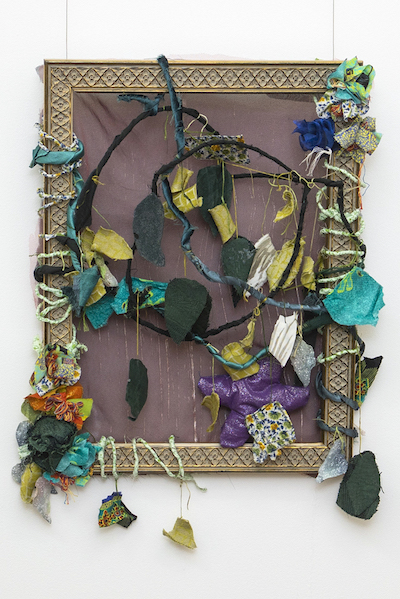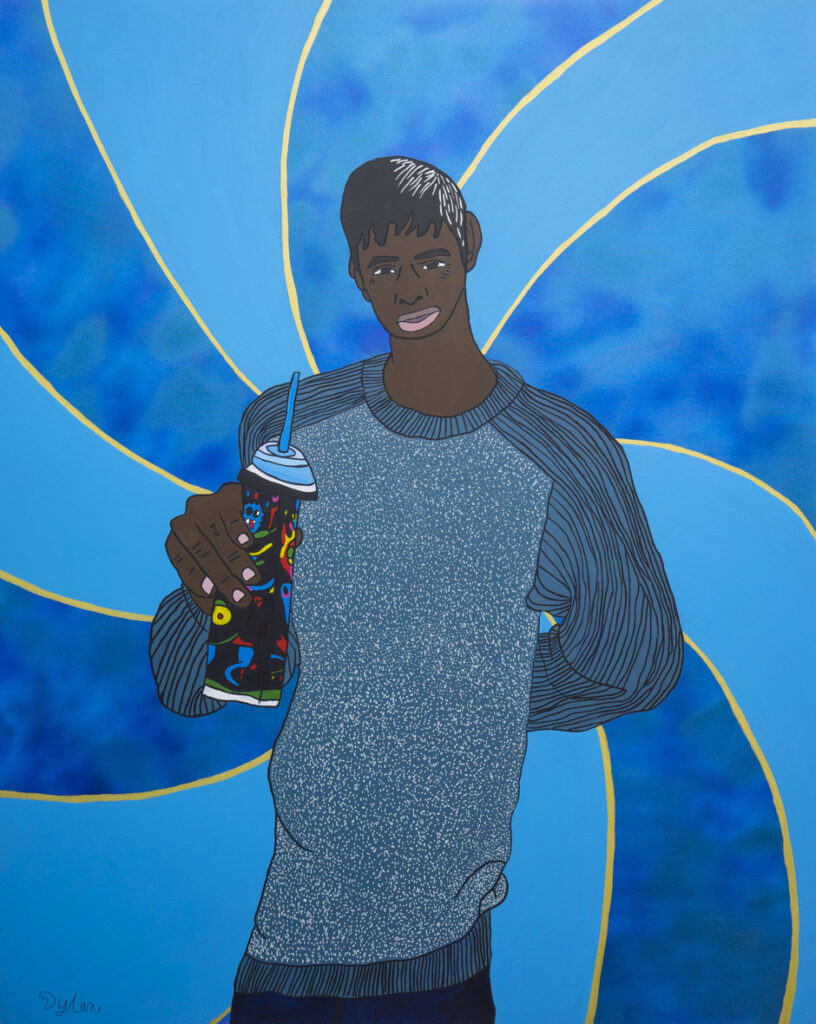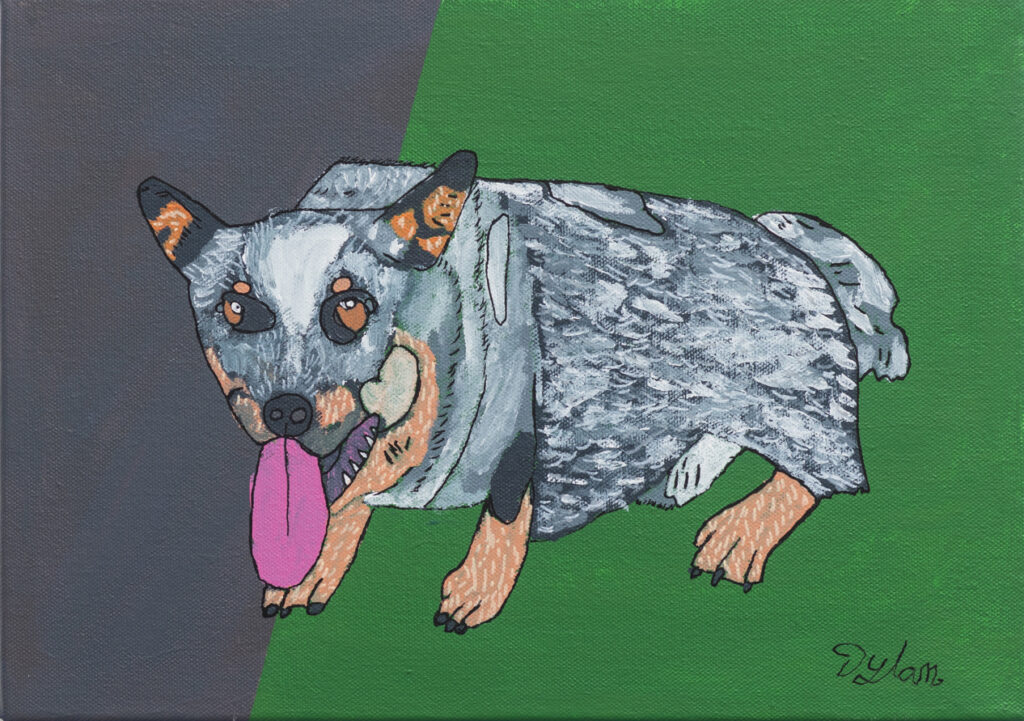Who says artworks should be for the eyes only? In two new exhibitions, DADAA offers a multi-sensory experience that feels fun and refreshing, writes Kim Kirkman.
Breaking the rules to tantalise the senses
14 June 2021
- Reading time • 8 minutesVisual Art
More like this
- A walk with Tina Stefanou
- A blaze of glorious people
- Diving into the gothic world of Erin Coates
‘TAP (Tactile Art Project)’ and ‘Blue Beautiful’, DADAA ·
Midland Junction Arts Centre, 12 June 2021 ·
Whether or not it’s stated explicitly, the rule in exhibitions is usually “look, don’t touch.”
In DADAA’s “TAP (Tactile Art Project)”, however, touching the artworks is not only permitted but encouraged.
Curated by Oliver-Max Taylor, “TAP” is a multi-sensory group exhibition presenting novel works that invite connection by touch. In doing so the exhibition both challenges traditional modes of interpreting art and offers accessibility to people with a range of disabilities.
The exhibition showcases works by 30 artists operating from DADAA’s nearby Midland Studio and incorporates a range of materials and techniques, ranging from ceramic sculpture, to paintings, to soft textiles.
The works transform a two-dimensional experience to one that is three-dimensional, and evoke, through touch, the same emotions that might be stirred by sight. But more than that, this invitation to a multi-sensory approach unearths a richer vein of exploration. New, true dimensions to expressions of cold or sharp or feathery or soft are possible, and objects depicted feel how they might in real life.

Emily Barker’s Free Natured presents an ornate picture frame entwined in fabric-clad wire vines, dripping leaves and free form shapes in patterned shades of green felt. Exploring the artwork by touch and sound other elements emerge; the sandy feel of a spangly cushion-starfish, the rustle and scrape of starched fabric evoking dry leaves in a breeze.
A feast for abstract exploration, Greg Harler’s GH is a large, hanging mobile in purples, pinks and mauves suspending elongated, curvilinear cushions on several twirled strings, some soft; others solid. Marcus Rusbridge’s Happy Hive, nearby, is a honeycomb of layer and texture, its sense of bustle discernible in the shape and quantity of its pop-out hexagons and chunky-bodied bees.
Oliver-Max Taylor, Prudence Dunkley and Debbie Mandat have created gorgeously bulbous ceramic vessels, as striking to the touch as the eye. Taylor’s graffiti-art scribble is reflected in form, in squiggly handles on the base and spout, and the spiny petals of Dunkley’s sunflowers and smooth curves of Mandat’s Lillies – stark red against a cream spiderweb of cracks – can be read also by running fingertips against the contours of their glazed surfaces.
Tim Maley deconstructs his untitled acrylic work for the audience by arranging a series of tactile objects alongside the canvas to illustrate the figures painted on it — toothpicks for a hedgehog’s spikes, a felt tissue-box wombat, varnished seeds for gravel, and a collection of soft feathers illustrating the bright parrot he has painted in the sky.
There are Diedre Gillespie’s Pom Pom Creatures, spindly legged, sharp-nosed and characterful, with shiny, varnished boots and soft bodies; Aiden Leahy’s pudding-like Christmas Tree topped with a five-pointed star; Nadia Leahy’s iridescent Pink Marlin spinning like a weathervane on its mossy base, with long tendril eyelashes and a tail and dorsal fins that flap on hinges.
Then there’s Sharon Pearce’s Eye See U, a large, coral-ringed eyeball within a conch shell nestled on a bed of eyeball-tipped anemones. Melania Tatham’s Living Down Under is a playful and moody Australiana scene, with an echidna, gumnuts and other local flora and fauna wrapped around a large circular vase in grooves and slashes, while Betty Helmsley’s fat-winged Dragonfly figures, in their muted patterns, crowd the neck of another like it is spilling nectar.
A degustation of shapes and forms and tonal variations, there are box-cities and figures with lid eyes and knob-faces and sculptures depicted in indentations and swirls and grooves and bumps. Oliver-Max Taylor’s Hideaway conceals small ceramic aliens and LED lights within a vase-like sculpture, the creatures identifiable by feel behind a large set of jagged teeth, a curved red tongue lolling out between them.

Exhibiting alongside “TAP”, and also presented by DADAA is “Blue Beautiful”, an installation by emerging artist Dylan Madurun, whose art practice connects a variety of subject matter with his favourite colour, blue. A series of mixed media canvas works installed along double strips of blue and featuring a blue slushie machine centerpiece offering “blue beautiful bubblegum” or “blue beautiful lemonade” slurpees, “Blue Beautiful” feels exuberant, boyish and Western Australian.
Blue marlin, bluebells and cut out blue Mini Coopers drawn from various angles are juxtaposed with ambient acrylic depictions the Blues Brothers, paint pen blueprints, and a blue-hyacinth macaw. Here and there, artworks like the Western Australian native Blue-Tongued Lizard are painted on gold, offsetting the blue, and an impish Blue Footed Booby incorporates gold foil.
Madurun’s Self-Portrait Kaleidoscope, Blue Wiggle (Anthony) and Blue Planet portraits are frank and expressive, their gestures dynamic and humorous. Hung adjacent to the slurpee machine, Blue Heaven Slurpee is a large acrylic and spray paint self-portrait whose naïve-style proportions have a simplicity and personality, evident also in the artist’s Blue Heeler and Blue Heeler-Puppy’s wonderful asymmetrical eyes and protruding tongues.
Presented within the kind of space typically characterised by that aforementioned rule against the touching of objects, and in a time defined by strict sanitation and social distancing, these two exhibitions feel fun and refreshing. By letting their materials speak for themselves the artworks enable a new element that taps into our universal experiences – the taste of sugar or the feel of a feather – which makes for an experience that is interactive, engaging; and inclusive to a broader range of audiences.
Pictured top: Diedre Gillespie, ‘Pom Pom Creatures’, 2020, mixed media, dimensions variable. Photo: Cameron Etchells

Like what you're reading? Support Seesaw.






